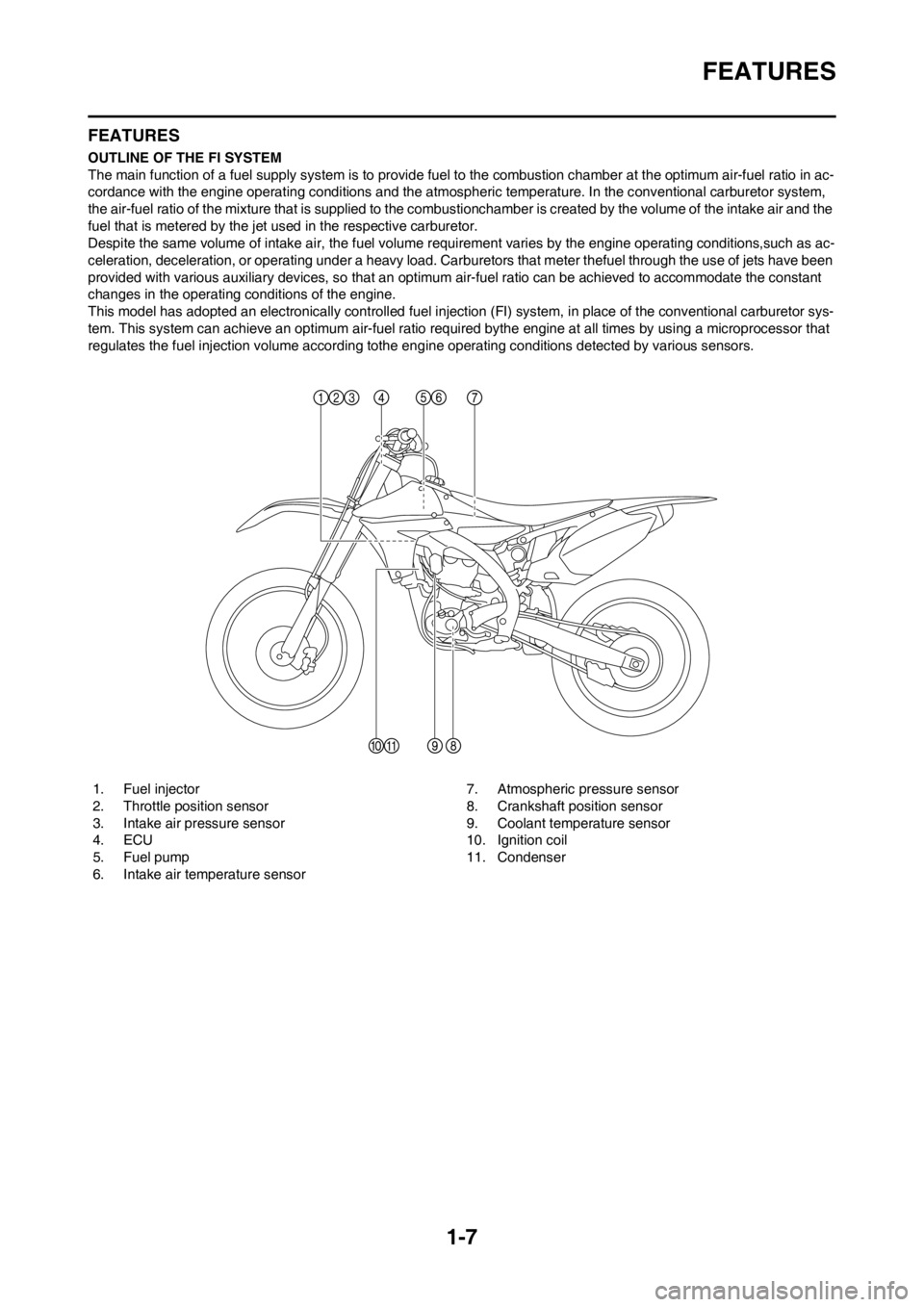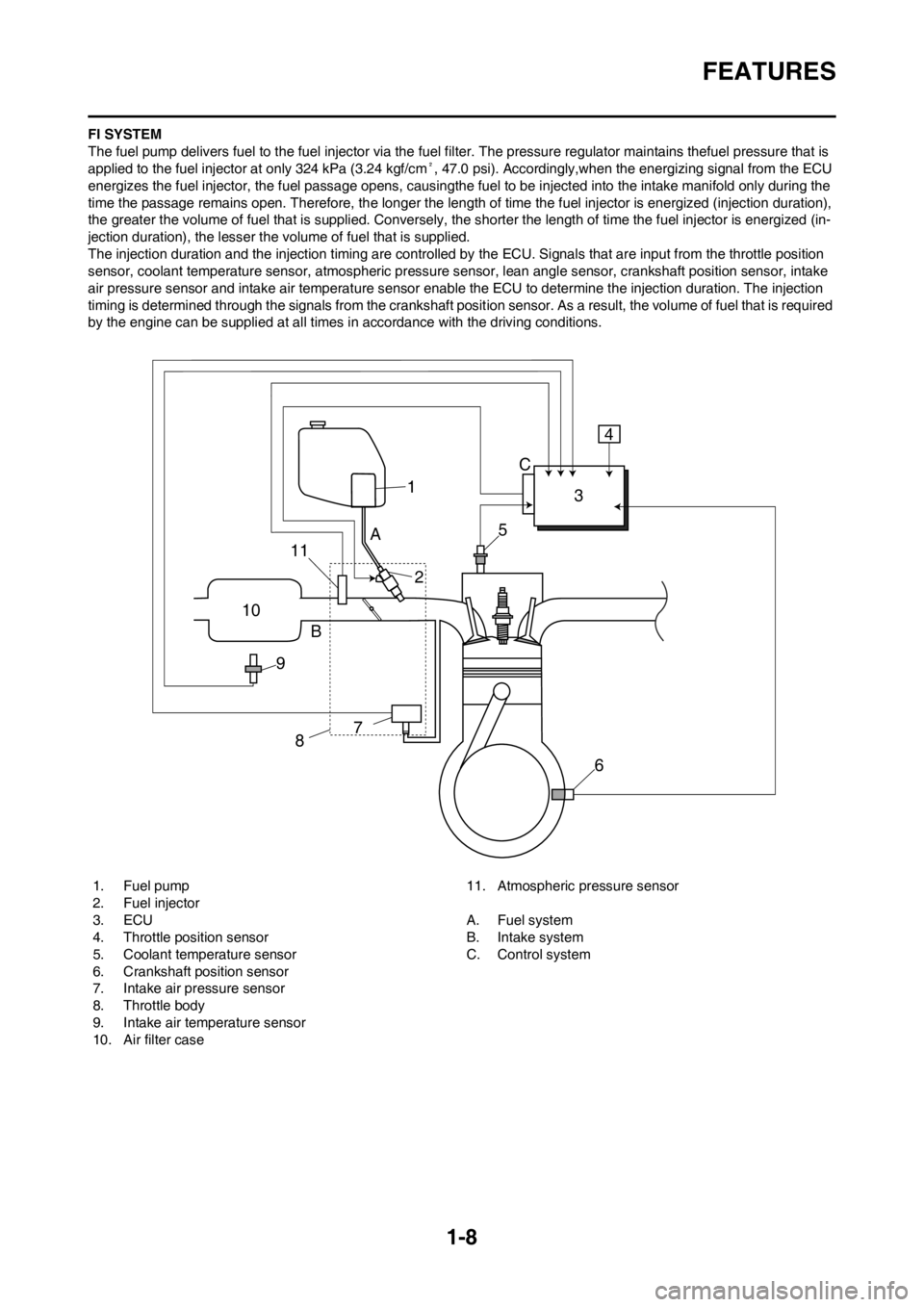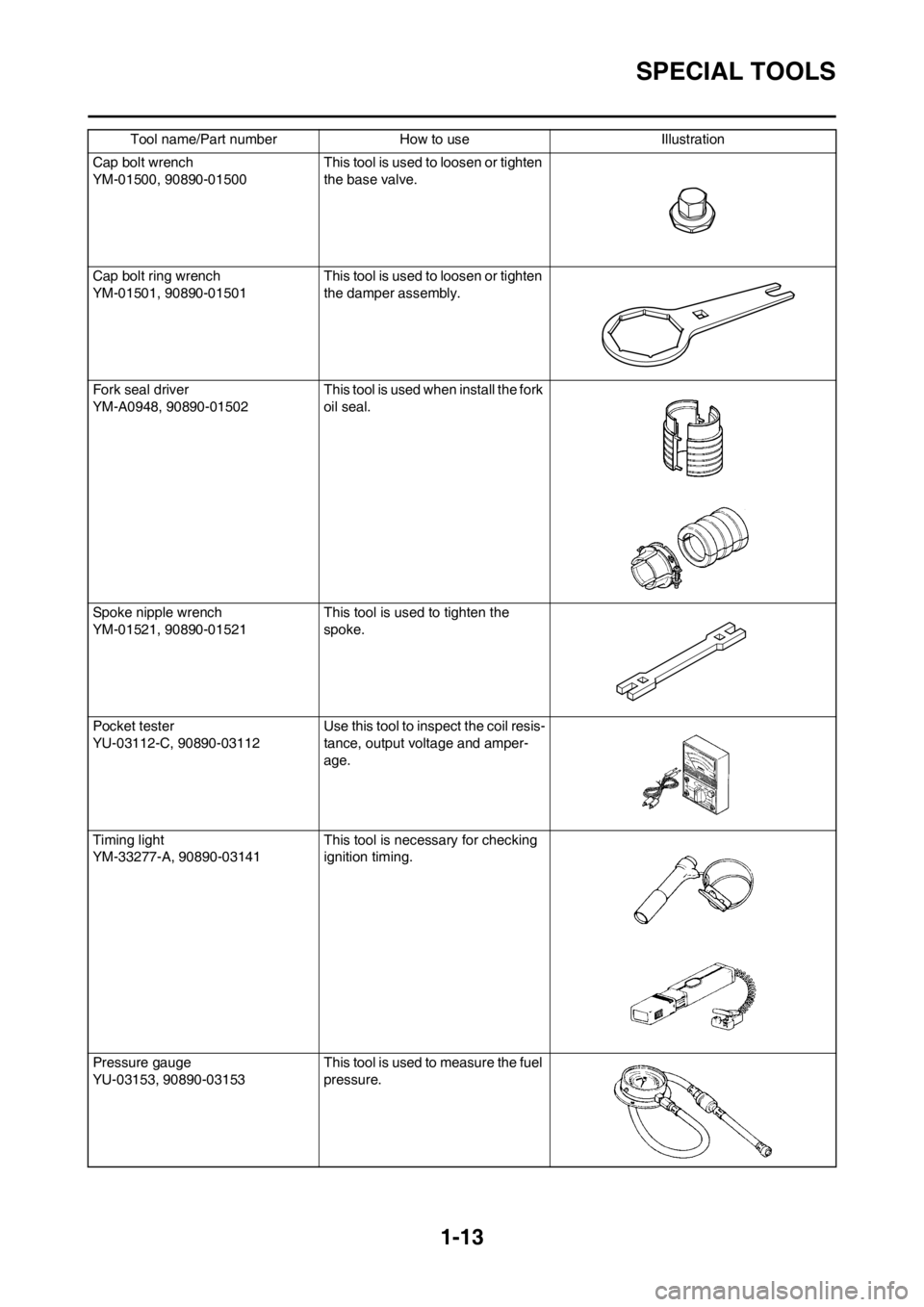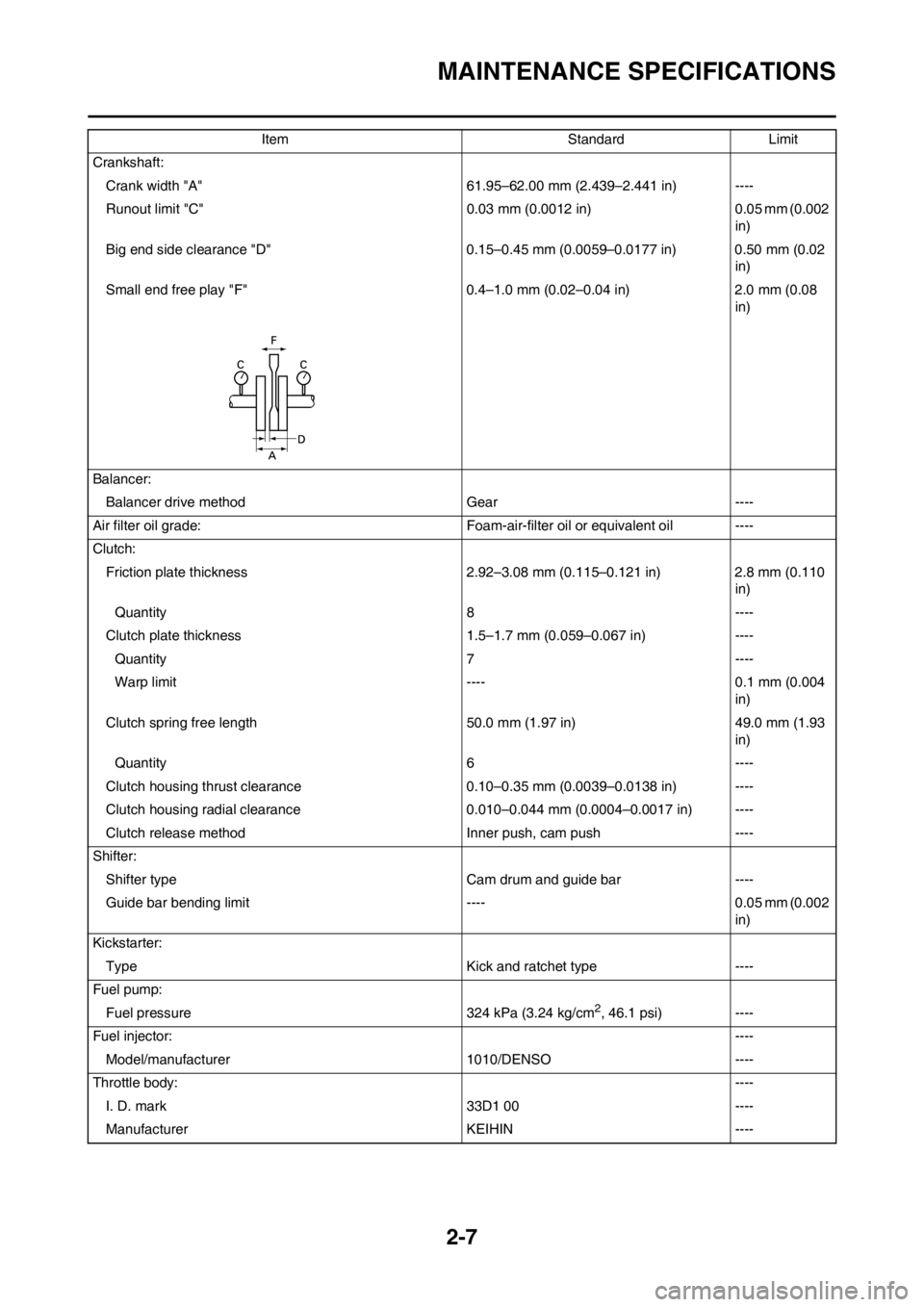fuel pressure YAMAHA YZ450F 2013 Owners Manual
[x] Cancel search | Manufacturer: YAMAHA, Model Year: 2013, Model line: YZ450F, Model: YAMAHA YZ450F 2013Pages: 228, PDF Size: 11.41 MB
Page 17 of 228

1-7
FEATURES
FEATURES
OUTLINE OF THE FI SYSTEM
The main function of a fuel supply system is to provide fuel to the combustion chamber at the optimum air-fuel ratio in ac-
cordance with the engine operating conditions and the atmospheric temperature. In the conventional carburetor system,
the air-fuel ratio of the mixture that is supplied to the combustionchamber is created by the volume of the intake air and the
fuel that is metered by the jet used in the respective carburetor.
Despite the same volume of intake air, the fuel volume requirement varies by the engine operating conditions,such as ac-
celeration, deceleration, or operating under a heavy load. Carburetors that meter thefuel through the use of jets have been
provided with various auxiliary devices, so that an optimum air-fuel ratio can be achieved to accommodate the constant
changes in the operating conditions of the engine.
This model has adopted an electronically controlled fuel injection (FI) system, in place of the conventional carburetor sys-
tem. This system can achieve an optimum air-fuel ratio required bythe engine at all times by using a microprocessor that
regulates the fuel injection volume according tothe engine operating conditions detected by various sensors.
1. Fuel injector
2. Throttle position sensor
3. Intake air pressure sensor
4. ECU
5. Fuel pump
6. Intake air temperature sensor7. Atmospheric pressure sensor
8. Crankshaft position sensor
9. Coolant temperature sensor
10. Ignition coil
11. Condenser
Page 18 of 228

1-8
FEATURES
FI SYSTEM
The fuel pump delivers fuel to the fuel injector via the fuel filter. The pressure regulator maintains thefuel pressure that is
applied to the fuel injector at only 324 kPa (3.24 kgf/cmΒ², 47.0 psi). Accordingly,when the energizing signal from the ECU
energizes the fuel injector, the fuel passage opens, causingthe fuel to be injected into the intake manifold only during the
time the passage remains open. Therefore, the longer the length of time the fuel injector is energized (injection duration),
the greater the volume of fuel that is supplied. Conversely, the shorter the length of time the fuel injector is energized (in-
jection duration), the lesser the volume of fuel that is supplied.
The injection duration and the injection timing are controlled by the ECU. Signals that are input from the throttle position
sensor, coolant temperature sensor, atmospheric pressure sensor, lean angle sensor, crankshaft position sensor, intake
air pressure sensor and intake air temperature sensor enable the ECU to determine the injection duration. The injection
timing is determined through the signals from the crankshaft position sensor. As a result, the volume of fuel that is required
by the engine can be supplied at all times in accordance with the driving conditions.
1. Fuel pump
2. Fuel injector
3. ECU
4. Throttle position sensor
5. Coolant temperature sensor
6. Crankshaft position sensor
7. Intake air pressure sensor
8. Throttle body
9. Intake air temperature sensor
10. Air filter case11. Atmospheric pressure sensor
A. Fuel system
B. Intake system
C. Control system
1
10
9B
87
6 5
A
23 C4
11
Page 19 of 228

1-9
INCLUDED PARTS
INCLUDED PARTS
DETACHABLE SIDESTAND
This sidestand "1" is used to support
only the machine when standing or
transporting it.
β’ Never apply additional force to
the sidestand.
β’ Remove this sidestand before
starting out.
VALVE JOINT
This valve joint "1" prevents fuel from
flowing out and is installed to the fuel
tank breather hose.
In this installation, make sure the
arrow faces the fuel tank and also
downward.
SPARK PLUG WRENCH
This spark plug wrench "1" is used to
remove and install the spark plug.
NIPPLE WRENCH
This nipple wrench "1" is used to
tighten the spoke.HANDLEBAR PROTECTOR
Install the handlebar protector "1" so
that the mark "a" face forward.
FUEL TANK HOLDING CABLE
The fuel tank holding cable "1" is
used to support the fuel tank during
maintenance.
FUEL HOSE JOINT COVER
The fuel hose joint covers "1" are
used to prevent mud, dust, and other
foreign material from entering the fuel
pump when the fuel hose is discon-
nected.
COUPLER FOR CONNECTING
OPTIONAL PART
This coupler "1" is used for connec-
tion to an optional Power Tuner and
so on.
When no optional parts, etc. are
connected, connect the connec-
tion terminal to the original cou-
pler "2".
Before removing the coupler, thor-
oughly wipe off any mud or water
stuck to it.
IMPORTANT INFORMATION
PREPARATION FOR REMOVAL
AND DISASSEMBLY
1. Remove all dirt, mud, dust, and
foreign material before removal
and disassembly.
β’ When washing the machine with
high pressured water, cover the
parts follows.
Air duct
Silencer exhaust port
Drain hole on the cylinder head
(right side)
Water pump housing hole at the
bottom
2. Use proper tools and cleaning
equipment. Refer to "SPECIAL
TOOLS" section.
3. When disassembling the ma-
chine, keep mated parts together.
They include gears, cylinders,
pistons, and other mated parts
that have been "mated" through
normal wear. Mated parts must
be reused as an assembly or re-
placed.
Part name Part number
YZ Power Tuner 33D-859C0-10
The YZ Power Tuner is optional.
Page 23 of 228

1-13
SPECIAL TOOLS
Cap bolt wrench
YM-01500, 90890-01500This tool is used to loosen or tighten
the base valve.
Cap bolt ring wrench
YM-01501, 90890-01501This tool is used to loosen or tighten
the damper assembly.
Fork seal driver
YM-A0948, 90890-01502 This tool is used when install the fork
oil seal.
Spoke nipple wrench
YM-01521, 90890-01521 This tool is used to tighten the
spoke.
Pocket tester
YU-03112-C, 90890-03112 Use this tool to inspect the coil resis-
tance, output voltage and amper-
age.
Timing light
YM-33277-A, 90890-03141 This tool is necessary for checking
ignition timing.
Pressure gauge
YU-03153, 90890-03153 This tool is used to measure the fuel
pressure. Tool name/Part number How to use Illustration
Page 24 of 228

1-14
SPECIAL TOOLS
FI diagnostic tool
YU-03182, 90890-03182This tool is used to check the fault
codes and diagnose any problems.
Fuel pressure adapter
YM-03186, 90890-03186This tool is used to attach the pres-
sure gauge.
Test harness S-pressure sensor
(3P)
YU-03207, 90890-03207This tool is connected between the
intake air pressure sensor and the
wire harness and is used to mea-
sure the voltage.
Test harness-speed sensor (3P)
YU-03208, 90890-03208This tool is connected between the
throttle position sensor and the wire
harness and is used to measure the
voltage.
FI diagnostic tool sub-lead
YU-03212, 90890-03212This tool is used to connect the FI di-
agnostic tool to a battery.
Valve guide remover & installer set
90890-04016This tool is needed to remove and
install the valve guide.
Valve spring compressor
YM-04019, 90890-04019This tool is needed to remove and
install the valve assemblies.
Clutch holding tool
YM-91042, 90890-04086This tool is used to hold the clutch
when removing or installing the
clutch boss securing nut. Tool name/Part number How to use Illustration
Page 30 of 228

1-20
CLEANING AND STORAGE
CLEANING AND STORAGE
CLEANING
Frequent cleaning of your machine
will enhance its appearance, maintain
good overall performance, and ex-
tend the life of many components.
1. Before washing the machine,
block off the end of the exhaust
pipe to prevent water from enter-
ing. A plastic bag secured with a
rubber band may be used for this
purpose.
2. If the engine is excessively
greasy, apply some degreaser to
it with a paint brush. Do not apply
degreaser to the chain, sprockets,
or wheel axles.
3. Rinse the dirt and degreaser off
with a garden hose; use only
enough pressure to do the job.
Do not use high-pressure washers
or steam-jet cleaners since they
cause water seepage and deterio-
ration seals.
4. After the majority of the dirt has
been hosed off, wash all surfaces
with warm water and a mild deter-
gent. Use an old toothbrush to
clean hard-to-reach places.
5. Rinse the machine off immediate-
ly with clean water, and dry all
surfaces with a soft towel or cloth.
6. Immediately after washing, re-
move excess water from the
chain with a paper towel and lubri-
cate the chain to prevent rust.
7. Clean the seat with a vinyl uphol-
stery cleaner to keep the cover
pliable and glossy.
8. Automotive wax may be applied
to all painted or chromed surfac-
es. Avoid combination cleaner-
waxes, as they may contain abra-
sives.
9. After completing the above, start
the engine and allow it to idle for
several minutes.STORAGE
If your machine is to be stored for 60
days or more, some preventive mea-
sures must be taken to avoid deterio-
ration. After cleaning the machine
thoroughly, prepare it for storage as
follows:
1. Fill up the fuel tank and add fuel
stabilizer (if available) to prevent
the fuel tank from rusting and the
fuel from deteriorating.
2. Remove the spark plug, pour a ta-
blespoon of SAE 10W-40 motor
oil in the spark plug hole, and re-
install the plug. With the engine
stop switch pushed in, kick the en-
gine over several times to coat the
cylinder walls with oil.
3. Remove the drive chain, clean it
thoroughly with solvent, and lubri-
cate it. Reinstall the chain or store
it in a plastic bag tied to the frame.
4. Lubricate all control cables.
5. Block the frame up to raise the
wheels off the ground.
6. Tie a plastic bag over the exhaust
pipe outlet to prevent moisture
from entering.
7. If the machine is to be stored in a
humid or salt-air environment,
coat all exposed metal surfaces
with a film of light oil. Do not apply
oil to rubber parts or the seat cov-
er.
Make any necessary repairs before
the machine is stored.
Page 32 of 228

2-2
GENERAL SPECIFICATIONS
Fuel:
Type Premium unleaded gasoline only
Tank capacity 6.2 L (1.40 Imp gal, 1.64 US gal)
Throttle body:
Type 30RA
Manufacturer KEIHIN
Spark plug:
Type/manufacturer CR8E/NGK (resistance type)
Gap 0.7β0.8 mm (0.028β0.031 in)
Clutch type: Wet, multiple-disc
Transmission:
Primary reduction system Gear
Primary reduction ratio 2.652 (61/23)
Final drive Chain
Secondary reduction ratio 3.692 (48/13) (For USA, CDN)
3.769 (49/13) (For EUROPE, AUS, NZ, ZA)
Transmission type Constant mesh, 5-speed
Operation Left foot operation
Gear ratio:
1st 1.929 (27/14)
2nd 1.533 (23/15)
3rd 1.278 (23/18)
4th 1.091 (24/22)
5th 0.952 (20/21)
Chassis: USA, CDN EUROPE AUS, NZ, ZA
Frame type Semi double cra-
dleββ
Caster angle 26.95Β° 26.80Β° 27.00Β°
Trail 118 mm (4.65 in) 117 mm (4.61 in) 120 mm (4.72 in)
Tire:
Type With tube
Size (front) 80/100-21 51M
Size (rear) 120/80-19 63M (For USA, CDN, AUS, NZ, ZA)
110/90-19 62M (For EUROPE)
Tire pressure (front and rear) 100 kPa (1.0 kgf/cm
2, 15 psi)
Brake:
Front brake type Single disc brake
Operation Right hand operation
Rear brake type Single disc brake
Operation Right foot operation
Suspension:
Front suspension Telescopic fork
Rear suspension Swingarm (link type monocross suspension)
Shock absorber:
Front shock absorber Coil spring/oil damper
Rear shock absorber Coil spring/gas, oil damper
Page 37 of 228

2-7
MAINTENANCE SPECIFICATIONS
Crankshaft:
Crank width "A" 61.95β62.00 mm (2.439β2.441 in) ----
Runout limit "C" 0.03 mm (0.0012 in) 0.05 mm (0.002
in)
Big end side clearance "D" 0.15β0.45 mm (0.0059β0.0177 in) 0.50 mm (0.02
in)
Small end free play "F" 0.4β1.0 mm (0.02β0.04 in) 2.0 mm (0.08
in)
Balancer:
Balancer drive method Gear ----
Air filter oil grade: Foam-air-filter oil or equivalent oil ----
Clutch:
Friction plate thickness 2.92β3.08 mm (0.115β0.121 in) 2.8 mm (0.110
in)
Quantity 8 ----
Clutch plate thickness 1.5β1.7 mm (0.059β0.067 in) ----
Quantity 7 ----
Warp limit ---- 0.1 mm (0.004
in)
Clutch spring free length 50.0 mm (1.97 in) 49.0 mm (1.93
in)
Quantity 6 ----
Clutch housing thrust clearance 0.10β0.35 mm (0.0039β0.0138 in) ----
Clutch housing radial clearance 0.010β0.044 mm (0.0004β0.0017 in) ----
Clutch release method Inner push, cam push ----
Shifter:
Shifter type Cam drum and guide bar ----
Guide bar bending limit ---- 0.05 mm (0.002
in)
Kickstarter:
Type Kick and ratchet type ----
Fuel pump:
Fuel pressure 324 kPa (3.24 kg/cm
2, 46.1 psi) ----
Fuel injector:----
Model/manufacturer 1010/DENSO ----
Throttle body:----
I. D. mark 33D1 00 ----
Manufacturer KEIHIN ----Item Standard Limit
Page 38 of 228

2-8
MAINTENANCE SPECIFICATIONS
Throttle position sensor:----
Throttle position sensor maximum resistance 5 kΞ©----
Throttle position sensor variable resistance 0β2 kΞ© (full closed) ----
Throttle position sensor input voltage 4β6 V ----
Fuel injection sensor:----
Crankshaft position sensor resistance 248β372 Ξ©----
Intake air pressure sensor output voltage 3.57β3.71 V at 101.3kPa (1.013 kg/cm
2,
14.41 psi)----
Atmospheric pressure sensor output voltage 3.57β3.71 V at 101.3kPa (1.013 kg/cm
2,
14.41 psi)----
Intake air temperature sensor 5.4β6.6 kΞ©at 0 Β°C (32 Β°F)
290β390 Ξ©at 80 Β°C (176 Β°F)----
Idling condition:----
Engine idle speed 1,900β2,100 r/min ----
Oil temperature 55β65 Β°C (131β149 Β°F) ----
Lubrication system:
Oil filter type Paper type ----
Oil pump type Trochoid type ----
Tip clearance 0.12 mm or less (0.0047 in or less) 0.20 mm (0.008
in)
Side clearance 0.09β0.17 mm (0.0035β0.0067 in) 0.24 mm (0.009
in)
Housing and rotor clearance 0.03β0.10 mm (0.0012β0.0039 in) 0.17 mm
(0.0067 in)
Bypass valve setting pressure 40β80 kPa (0.4β0.8 kg/cm
2, 5.69β11.38
psi)----
Cooling:
Radiator core size
Width 121.4 mm (4.78 in) ----
Height 235 mm (9.25 in) ----
Thickness 28 mm (1.10 in) ----
Radiator cap opening pressure 108β137 kPa (1.08β1.37 kg/cm
2, 15.4β
19.5 psi)----
Radiator capacity (total) 0.62 L (0.55 Imp qt, 0.66 US qt) ----
Water pump
Type Single-suction centrifugal pump ----Item Standard Limit
Page 53 of 228

2-23
CABLE ROUTING DIAGRAM
1. Tension pipe
2. Coolant temperature sensor
coupler
3. Front engine bracket
4. Fuel pump coupler
5. Fuel pump
6. Intake air temperature sensor
coupler
7. Radiator hose 2
8. Radiator breather hose
9. Radiator hose 1
10. Radiator hose 4
11. Radiator pipe 2
12. Radiator hose 3
13. Cylinder head breather hose
14. Frame
15. ECU (electronic control unit)
16. ECU bracket
17. Main harness
18. AC magneto lead
19. Throttle position sensor lead
20. Condenser lead
21. Coolant temperature sensor
lead
22. Ignition coil lead
23. CondenserA. Fasten the wire harness at the
positioning tape to the ECU
bracket with a plastic locking tie.
Face the buckle of the plastic
locking tie downward, and then
cut off the excess end of the tie.
B. Install the cover onto the wire
harness coupler.
C. Route the condenser lead, throt-
tle position sensor lead, coolant
temperature sensor lead, igni-
tion coil lead, and AC magneto
lead under radiator hose 2.
D. Connect the vacuum hose to the
atmospheric pressure sensor,
and then fasten the hose with
the clamp. Make sure to face the
moving part of the sensor rear-
ward.
E. After connecting the condenser
coupler, install the coupler cover
onto the coupler.
F. After connecting the throttle po-
sition sensor coupler, install the
coupler cover onto the coupler.
G. Fasten the AC magneto lead,
condenser lead, throttle position
sensor lead, coolant tempera-
ture sensor lead, and ignition
coil lead to the frame with the
plastic band, making sure to po-
sition the band between the igni-
tion coil bracket and the tension
pipe. Face the buckle of the
plastic band to the right with the
end pointing rearward.
H. Point the end of the vacuum
hose rearward.
I. Fit the bracket into the hole in
the rubber portion of the con-
denser.
J. Fasten the radiator breather
hose to the frame with the plas-
tic band, making sure to position
the band above the front engine
bracket. Face the buckle of the
plastic band outward with the
end pointing rearward.
K. After connecting the coolant
temperature sensor coupler, in-
stall the coupler cover onto the
coupler.L. Route the radiator breather hose
between the down tubes.
M. Fasten the fuel hose and fuel
pump lead with the plastic band,
making sure to position the band
between the bend in the fuel
hose protector and the end of
the protector. Point the end of
the plastic band upward.
N. Insert the projection on the joint
coupler into the hole in the
bracket, and then install the cou-
pler cover onto the coupler.
O. Route the atmospheric pressure
sensor lead, intake air pressure
sensor lead, intake air tempera-
ture sensor lead, fuel injector
lead, and fuel pump lead above
radiator hose 2. Position the
joint coupler above radiator
hose 2.
P. Route the radiator breather hose
to the inside of radiator hose 1
and the front engine bracket.
Q. Hose installation position (1.3β
3.3 mm, 0.05β0.13 in)
R. Clip installation position (0β2.0
mm, 0β0.08 in)
S. Install the washer so that it con-
tacts the bolt head.
T. Install the collar so that the
flange on the collar contacts the
ECU bracket.
U. 6 mm (0.24 in) or less